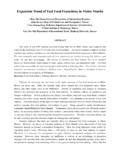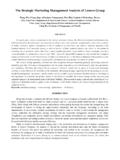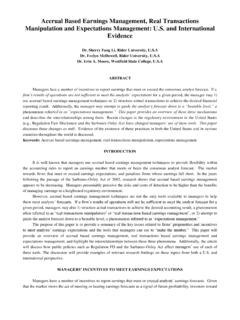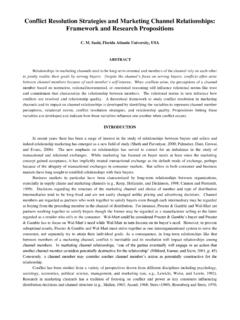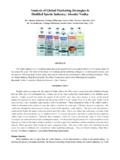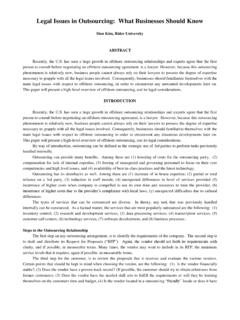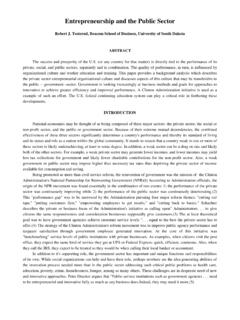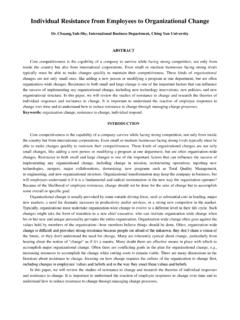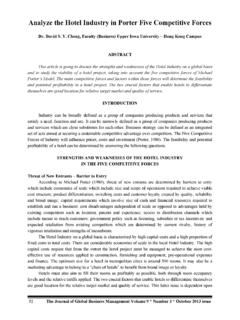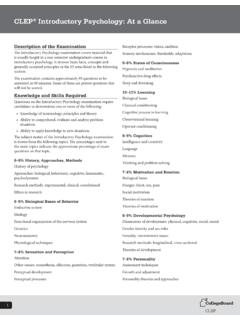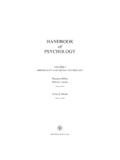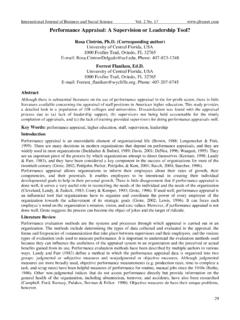Transcription of The Investment Behavior, Decision Factors and …
1 The Investment behavior , Decision Factors and Their Effects Toward Investment Performance in the Taiwan Stock Market Yu-Je Lee, Dept. of Marketing Management, Takming University of Science and Technology Gao-Liang Wang, Graduate Institute of Business Management in Service Industry, Takming University of Science and Technology Kae-Shuan Kao, Dept. of Public Finance, Takming University of Science and Technology Ching-Yaw Chen, Graduate School of Business Administration, Shu-Te University Fong-Ping Zhu, Graduate School of Business Administration, Shu-Te University ABSTRACT This study aims to discuss how Investment behavior and Decision Factors affect performances of the Taiwan stock market. The research targets are randomly selected Taiwan stock market investors. Through use of examining the frequency distribution tables and one-way ANOVA, background variables of investors were explored in an examination of how these variables affect the Investment behavior and Decision Factors towards performance on the Taiwan stock market.
2 To further analyze the correlations among variables, this study implemented Pearson Product-moment Correlation Coefficient, which included verification of significant effects on investor behaviors and Decision Factors . CATREG (regression with optimal scaling) were adopted to predict effects on Investment behavior and Decision Factors towards performance on the Taiwan stock market, and to explain correlation among variables. The study hypothesized that there was no significant differences between Investment behavior and Decision Factors with the investor s background variable. However, this study result concluded that there indeed existed significant differences on investor Decision -making on market selection according to their assets. On the other hand, other variables, such as gender, age, marital status, education, career and job lever income, and average amount for quarterly Investment appeared not to have significant differences.
3 Furthermore, among the variables, the most significant influential Factors on the performance on the Taiwan stock market were macroeconomic forces followed by market selection, and finally investor expectations. Keywords: Investment behavior , Decision Factors , and Investment performance BACKGROUND The Taiwan stock market was established in February 1962, and at that time, comprehensive stock trading led the Taiwan capitalization weighted stock index to increase by nearly 6000 points. However, during the last 47 years, there have been tremendous changes. Before 1986, Investment was not a common practice, and the economy and the Taiwan stock market experienced downturn; after 1986, due to rapid growth of the economy and corresponding increases in exports, domestic surplus capitals led to a bull market. In 1989, the market-share weighted index increased to 10, 000, and reached its record high of 12,682 in 1990.
4 Most investors gained from stock Investment at that time, but later, the economic bubble resulted in a sharp decrease of the Taiwan stock market index, and in 1991, the market-share weighted index decreased to 3000, and most investors who stayed in the market lost all their Investment . Still, investors wanted to maintain/get back their initial Investment and to improve their performance from the stock market (Miao, 2002). From 2007 till now, the sub-prime mortgage crisis and bankruptcy of Lehman Brothers resulted in the most serious financial crisis in the past century, said Former Federal Reserve Chairman Alan Greenspan. Investors were regretful of cashing out their investments before the crisis. Is there any Investment analysis method to assist investors to manage the stock market movement to minimize investors loss or even gain from the stock market? Yet, studies on discussing effects on investor behavior and Decision Factors towards Investment performance on the stock market are limited, which is the motivation for this study.
5 Hence, the purposes of this study in summarize are to measure: on variable of investors background towards Investment performance of Taiwan the stock market. on investors behaviors towards Investment performance of the Taiwan stock market. on Decision Factors towards Investment performance of the Taiwan stock market. LITERATURE REVIEW Studies on investors Investors in the Taiwan stock market are categorized into six different types according to their characteristics: Direct Investment Investment Trusts Traders of Supervisors/Directors of publicly listed companies (also referred to as Insiders) Investor, who holds several hundred millions of Investment , also referred to as market traders/outsiders Investor, whose invested amount is within several millions. (Taiwan Stock Exchange Regulation, 2009) Studies on Investment Hehavior Definition of Investment behavior Investment behaviors are defined as how the investors judge, predict, analyze and review the procedures for Decision making, which includes Investment psychology, information gathering, defining and understanding, research and analysis.
6 The whole process is Investment behavior (Slovic, 1972; Alfredo and Vicente, 2010). In this paper this definition is adopted. Market Selection The key point for selecting Investment behaviors, selections of market or strategy regardless is the relation between returns and risks; which is to select Investment targets with good credibility, large company size, high dividends, and high returns. However, high returns usually come with high risks; hence, the ultimate target for the investor is to select investments that balance risks and returns (Peng, Yu-Jan, 2003). Selecting Strategy Definition of strategy: Strategy was firstly used in the military; originally from Greek, strategos , meaning commander or commanding skills. After discovery of game theory, strategy was then applied; the concept has been rapidly developed even after 1960.
7 Chandler (1962) believed strategy decides long-term corporate goals, action plans and resource allocation to reach this goal. Another scholar, Kotler (1976) thought strategy is a whole picture design for companies to reach the planned strategy, which is also an integrated action plan for marketing, finance and manufacturing. Burnie and Ridder (2010) show that investors, individuals as well as corporations, use simple passive Investment strategies and hence do not believe in market timing or wish to risk capital on capturing far tail or swan-type returns. The strategy selections discussed in this paper are the expected returns or weighted Investment capital of short-term, mid-term, and long-term strategy. It also discusses correlation between choosing trade strategy and Investment performance. In the definition of general strategy selection and Investment holding period, long-term Investment means to hold the Investment for more than 1 year, mid-term Investment is for 3 months to 1 year while short-term Investment is to hold less than 3 months.
8 As regards to Investment returns in long-term, mid-term and short-term trading, trading cost is the key factor. Studies on Investment Decision Factors Investment Decision Fahlenbrach (2009) research Founder-CEOs, Investment Decisions, and Stock Market Performance and the implications of the Investment behavior and stock market performance of founder-CEO firms are discussed. Culters, Poterba & Lawrence (1989) believed Decision -making is a baffling phenomenon. The common analytical methods in practices are categorized into fundamental, technical, traded volume and political Factors . Precious and excess information sometimes leads to inconsistent decisions. This study also believed investors psychology and expectations are also key Factors to Investment performance. The above mentioned papers increase our study s subject matters as they are related to our research subject.
9 Definition of Fundamental Factors Security Analysis by Benjamin Graham and David Dodd (1934) is used to decide intrinsic value of stocks based on studying Factors of economy situations, industry trend and sales revenues of those companies. It focuses on long-term analysis, which is referred to as fundamental analysis. Benjamin Graham is also the Father of fundamental analysis. Definition of Technical Analysis Technical analysis originated from Sakata Strategy, developed by a rice trader, Homma Munehisa in the 19th century that was originally applied to the rice futures exchange market in Japan. Since then, it has gradually developed, with market experiences, innovations and development into the Candlestick Chart. The Candlestick chart is a style of bar chart used primarily to predict price movement of financial markets. In the early 19th century, other technical analysis was developed, such as Dow Theory.
10 Dow Theory derived from Wall Street Journal editorials written by Charles H. Dow, founder of the Wall Street Journal during 1900 to 1902. Following his death in 1902, William Peter Hamilton summarized his articles and organized them into The Stock Market Barometer in 1922. After The Dow Theory was redefined and expanded in 1932 by Robert Rhea, the Dow Theory then had a completed framework. Dow Theory takes average indices of the Dow Jones Industrial Average and DJRA to determine business cycles that signal business activities. Other technical analytical theories like Wave Theory, RSI, KD, MA, MACD, and OBV were developed in the 20th century. Definition of Psychological Factor Psychology studies how minds work which originally means the study of mind. Psychologists discuss how human learn, think, and communicate; experiencing emotions and dealing with information for Decision -making factor, and how these become core concepts to individual behaviors.
